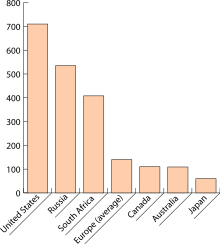Frequency (statistics)

In statistics the frequency (or absolute frequency) of an event is the number of times the observation occurred/recorded in an experiment or study.[1]: 12–19 These frequencies are often graphically represented in histograms.
Types
The cumulative frequency is the total of the absolute frequencies of all events at or below a certain point in an ordered list of events.[1]: 17–19
The relative frequency (or empirical probability) of an event is the absolute frequency normalized by the total number of events:
The values of for all events can be plotted to produce a frequency distribution.
In the case when for certain i, pseudocounts can be added.
Depictions
The following are some commonly used methods of depicting frequency:[2]
Histograms
A histogram is a representation of tabulated frequencies, shown as adjacent rectangles or squares (in some of situations), erected over discrete intervals (bins), with an area proportional to the frequency of the observations in the interval. The height of a rectangle is also equal to the frequency density of the interval, i.e., the frequency divided by the width of the interval. The total area of the histogram is equal to the number of data. A histogram may also be normalized displaying relative frequencies. It then shows the proportion of cases that fall into each of several categories, with the total area equaling 1. The categories are usually specified as consecutive, non-overlapping intervals of a variable. The categories (intervals) must be adjacent, and often are chosen to be of the same size.[3] The rectangles of a histogram are drawn so that they touch each other to indicate that the original variable is continuous.[4]
Bar graphs


A bar chart or bar graph is a chart with rectangular bars with lengths proportional to the values that they represent. The bars can be plotted vertically or horizontally. A vertical bar chart is sometimes called a column bar chart.
Frequency distribution table
A frequency distribution table is an arrangement of the values that one or more variables take in a sample. Each entry in the table contains the frequency or count of the occurrences of values within a particular group or interval, and in this way, the table summarizes the distribution of values in the sample. An example is shown below
| Rank | Degree of agreement | Number |
|---|---|---|
| 1 | Strongly agree | 20 |
| 2 | Agree somewhat | 30 |
| 3 | Not sure | 20 |
| 4 | Disagree somewhat | 15 |
| 5 | Strongly disagree | 15 |
Interpretation
Under the frequency interpretation of probability, it is assumed that as the length of a series of trials increases without bound, the fraction of experiments in which a given event occurs will approach a fixed value, known as the limiting relative frequency.[5][6]
This interpretation is often contrasted with Bayesian probability. In fact, the term 'frequentist' was first used by M. G. Kendall in 1949, to contrast with Bayesians, whom he called "non-frequentists".[7][8] He observed
- 3....we may broadly distinguish two main attitudes. One takes probability as 'a degree of rational belief', or some similar idea...the second defines probability in terms of frequencies of occurrence of events, or by relative proportions in 'populations' or 'collectives'; (p. 101)
- ...
- 12. It might be thought that the differences between the frequentists and the non-frequentists (if I may call them such) are largely due to the differences of the domains which they purport to cover. (p. 104)
- ...
- I assert that this is not so ... The essential distinction between the frequentists and the non-frequentists is, I think, that the former, in an effort to avoid anything savouring of matters of opinion, seek to define probability in terms of the objective properties of a population, real or hypothetical, whereas the latter do not. [emphasis in original]
See also
- Aperiodic frequency
- Cumulative frequency analysis
- Law of large numbers
- Multiset multiplicity as frequency analog
- Probability density function
- Statistical regularity
- Word frequency
References
- ^ a b Kenney, J. F.; Keeping, E. S. (1962). Mathematics of Statistics, Part 1 (3rd ed.). Princeton, NJ: Van Nostrand Reinhold.
- ^ Carlson, K. and Winquist, J. (2014) An Introduction to Statistics. SAGE Publications, Inc. Chapter 1: Introduction to Statistics and Frequency Distributions
- ^ Howitt, D. and Cramer, D. (2008) Statistics in Psychology. Prentice Hall
- ^ Charles Stangor (2011) "Research Methods For The Behavioral Sciences". Wadsworth, Cengage Learning. ISBN 9780840031976.
- ^ von Mises, Richard (1939) Probability, Statistics, and Truth (in German) (English translation, 1981: Dover Publications; 2 Revised edition. ISBN 0486242145) (p.14)
- ^ The Frequency theory Chapter 5; discussed in Donald Gilles, Philosophical theories of probability (2000), Psychology Press. ISBN 9780415182751 , p. 88.
- ^ Earliest Known Uses of Some of the Words of Probability & Statistics
- ^ Kendall, Maurice George (1949). "On the Reconciliation of Theories of Probability". Biometrika. 36 (1/2). Biometrika Trust: 101–116. doi:10.1093/biomet/36.1-2.101. JSTOR 2332534.





